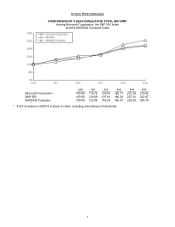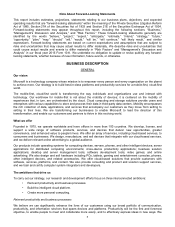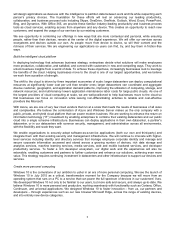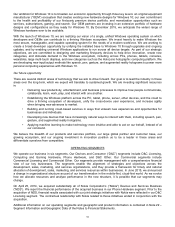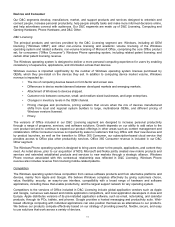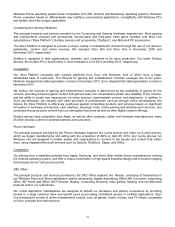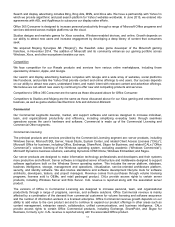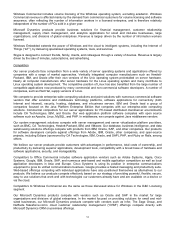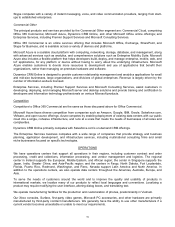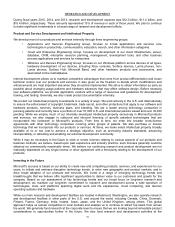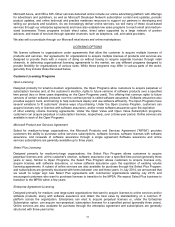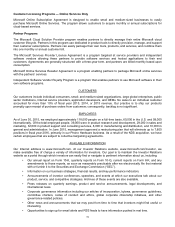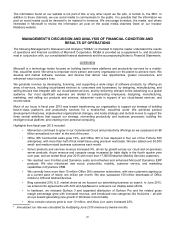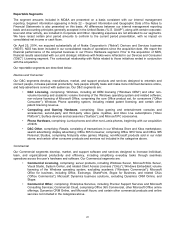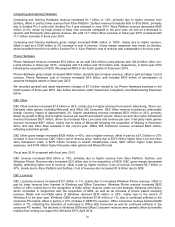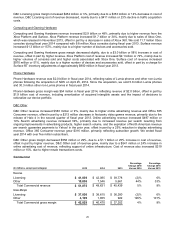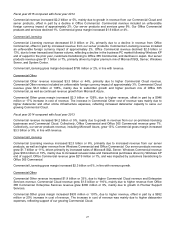Microsoft 2015 Annual Report Download - page 18
Download and view the complete annual report
Please find page 18 of the 2015 Microsoft annual report below. You can navigate through the pages in the report by either clicking on the pages listed below, or by using the keyword search tool below to find specific information within the annual report.
17
business segment level. Much of our business segment level research and development is coordinated with other
segments and leveraged across the company.
In addition to our main research and development operations, we also operate Microsoft Research. Microsoft
Research is one of the world’s largest computer science research organizations, and works in close collaboration
with top universities around the world to advance the state-of-the-art in computer science, providing us a unique
perspective on future technology trends and contributing to our innovation.
DISTRIBUTION, SALES, AND MARKETING
We market and distribute our products and services through the following channels: OEMs; distributors and resellers;
online; and Microsoft retail stores. Our sales force performs a variety of functions, including working directly with
enterprises and public sector organizations worldwide to identify and meet their software requirements; managing
OEM relationships; and supporting solution integrators, independent software vendors, and other partners who
engage directly with our customers to perform sales, consulting, and fulfillment functions for our products.
OEMs
We distribute software through OEMs that pre-install our software on new PCs, tablets, servers, phones, and other
intelligent devices that they sell. The largest component of the OEM business is the Windows operating system pre-
installed on computing devices. OEMs also sell hardware pre-installed with other Microsoft products, including server
and embedded operating systems and applications such as our Microsoft Office suite. In addition to these products,
we also market our services through OEMs and service bundles such as Windows with Bing or Windows with Office
365 subscription.
There are two broad categories of OEMs. The largest OEMs, many of which operate globally, are referred to as
“Direct OEMs,” as our relationship with them is managed through a direct agreement between Microsoft and the
OEM. We have distribution agreements covering one or more of our products with virtually all of the multinational
OEMs, including Acer, ASUSTeK, Dell, Fujitsu, Hewlett-Packard, Lenovo, Samsung, Toshiba, and with many
regional and local OEMs. The second broad category of OEMs consists of lower-volume PC manufacturers (also
called “system builders”), which source their Microsoft software for pre-installation and local redistribution primarily
through the Microsoft distributor channel rather than through a direct agreement or relationship with Microsoft.
Distributors and Resellers
Many organizations that license our products and services through enterprise agreements transact directly with us,
with sales support from solution integrators, independent software vendors, web agencies, and developers that
advise organizations on licensing our products and services (“Enterprise Agreement Direct Advisors”, or “EDAs”).
Organizations also license our products and services indirectly, primarily through license solutions partners (“LSPs”),
distributors, value-added resellers (“VARs”), OEMs, system builder channels, and retailers. Although each type of
reselling partner reaches organizations of all sizes, LSPs are primarily engaged with large organizations, distributors
resell primarily to VARs, and VARs typically reach small-sized and medium-sized organizations. EDAs typically are
also authorized as LSPs and operate as resellers for our other licensing programs, such as the Select Plus and Open
licensing programs discussed under “Licensing Options” below. Some of our distributors include Ingram Micro and
Tech Data, and some of our largest resellers include CDW, Dell, Insight Enterprises, and Software House
International.
Our Microsoft Dynamics software offerings are also licensed to enterprises through a global network of channel
partners providing vertical solutions and specialized services. We distribute our retail packaged products primarily
through independent non-exclusive distributors, authorized replicators, resellers, and retail outlets. Individual
consumers obtain these products primarily through retail outlets, including Microsoft retail stores. We distribute our
hardware products, including Surface, Xbox, phones, and PC accessories, through third-party retailers and Microsoft
retail stores. Our phones are also distributed through global wireless communications carriers. We have a network of
field sales representatives and field support personnel that solicits orders from distributors and resellers, and
provides product training and sales support.
Online
Although on-premises software continues to be an important part of our business, increasingly we are delivering
additional value to customers through cloud-based services. We provide online content services to consumers
through Bing, MSN portals and channels, Office 365, Windows Phone Store, Xbox Live, Outlook.com, OneDrive,
Skype, and Windows Store. We also provide commercial cloud-based services such as Dynamics CRM Online,


